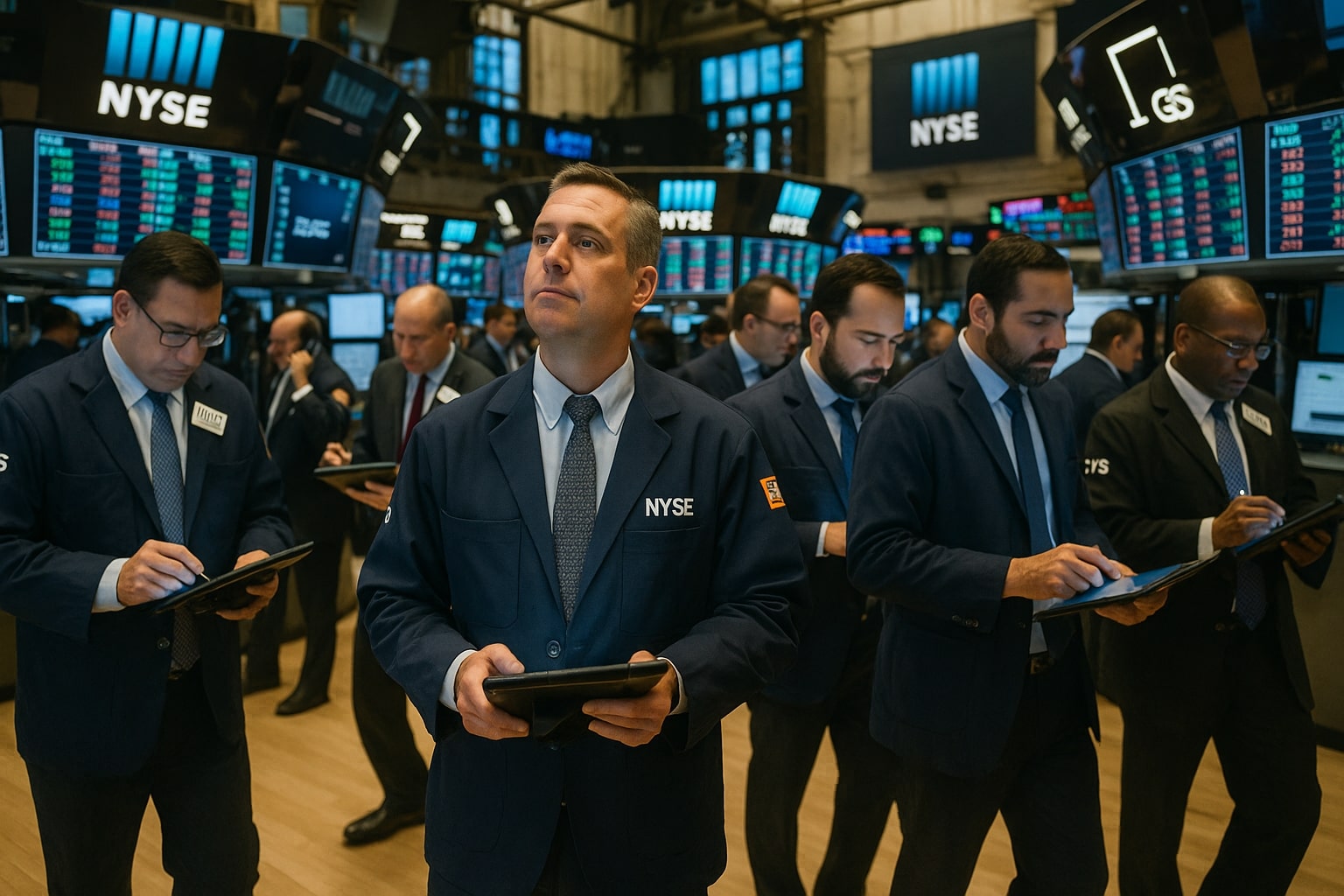Stock Market Today: Wall Street Surges as AI and Retail Spark a Powerful Reversal
Wall Street staged a forceful rebound driven by Nvidia (NASDAQ:NVDA) and Walmart (NYSE:WMT), ending a volatile week with renewed confidence in corporate earnings and the AI growth cycle. The Dow Jones Industrial Average advanced 706 points (+1.5%) to 46,738.13, while the S&P 500 (SPX) climbed 1.64% to 6,751.39. The Nasdaq Composite (COMP) outperformed with a 2.13% rally to 23,045.24, posting its strongest session in weeks as semiconductor and megacap technology stocks roared higher. The Russell 2000 gained 2.31% to 2,402.13, signaling a broad-based recovery extending beyond large caps.
Risk sentiment improved dramatically after a confluence of positive catalysts: Nvidia’s record-breaking quarter, Walmart’s retail strength, and a stronger-than-expected U.S. jobs report suggesting a resilient but cooling economy. The 10-year Treasury yield eased to 4.119%, and the Cboe VIX index dropped 16.06% to 19.86, reflecting a sharp contraction in volatility. The U.S. dollar index (DXY) held stable near 97.58, while capital rotated back into equities from defensive assets.
Nvidia Reignites the AI Boom and Restores Market Leadership
The day’s turning point came from Nvidia (NVDA), whose quarterly report not only beat Wall Street’s lofty expectations but reaffirmed the durability of the AI infrastructure cycle. The company reported $57.01 billion in revenue and $1.30 EPS, outperforming analyst projections of $54.92 billion and $1.25. The guidance for Q4 revenue at $65 billion, far exceeding the $61.66 billion consensus, demonstrated sustained demand for its Blackwell architecture chips, now described by CEO Jensen Huang as “off the charts.”
Huang directly addressed investor fears of an AI bubble, emphasizing that this expansion represents industrial-scale computing transformation, not speculation. The comment shifted sentiment across global markets. The stock surged 5% to $192.80, recouping losses from earlier in the month.
The rally extended across the semiconductor ecosystem: Advanced Micro Devices (NASDAQ:AMD) rose 4%, Broadcom (NASDAQ:AVGO) gained 3%, Super Micro Computer (NASDAQ:SMCI) jumped 5%, and Taiwan Semiconductor (NYSE:TSM) climbed 3%. The VanEck Semiconductor ETF (NYSEARCA:SMH) advanced 2.07% to $346.48, while the Roundhill Magnificent Seven ETF (NASDAQ:MAGS) gained 2.6% to $65.73, its strongest performance since late May.
Market participants highlighted that Nvidia’s record sales erased doubts surrounding inflated AI valuations. Operating margins above 50%, robust order backlogs, and global demand spanning from Amazon (NASDAQ:AMZN) to Google (NASDAQ:GOOGL) confirmed structural rather than speculative growth. Ray Dalio, founder of Bridgewater, said investors shouldn’t “sell just because there’s a bubble,” adding that AI’s productivity gains make current multiples sustainable relative to long-term returns.
Nvidia’s performance also reassured macro investors that the AI-driven capex wave remains the core engine of equity expansion. Analysts now estimate the firm’s market capitalization could surpass $5 trillion by mid-2026 if quarterly sales sustain above $60 billion.
Walmart Strengthens Consumer Confidence with Stellar Results
Walmart (WMT) delivered a performance that redefined retail sector sentiment. Shares jumped 6.15% to $106.80, its biggest one-day gain since April 9, when Trump’s tariff pause last triggered a comparable rally. The company’s Q3 revenue of $179.5 billion exceeded expectations of $177.4 billion, while adjusted EPS of $0.62 topped forecasts of $0.60.
The retailer raised its full-year guidance, attributing growth to a 25% increase in U.S. e-commerce and a significant expansion in higher-income consumer engagement. CFO John David Rainey said Walmart is capturing “value-seeking customers across income brackets,” emphasizing that the company’s omnichannel model is drawing shoppers from Amazon and Target.
Adding to the momentum, Walmart announced it will move its stock listing from the NYSE to the Nasdaq on December 9, underscoring its evolution into a tech-driven retail platform. The company also confirmed talks to acquire Israeli data security firm R&A Data, reflecting efforts to tighten oversight of its vast third-party marketplace.
Walmart’s performance contrasts with broader retail trends that have shown margin compression across the sector. The firm’s consistent traffic growth and technology investments in logistics and digital commerce reinforce its competitive moat. It now leads the Dow Jones Industrial Average both in price momentum and earnings revision strength.
AI Ecosystem and the Magnificent Seven Regain Dominance
The broader technology complex followed Nvidia’s lead. Tesla (NASDAQ:TSLA) surged 5%, while Alphabet (NASDAQ:GOOGL) and Microsoft (NASDAQ:MSFT) each climbed more than 3%. Apple (NASDAQ:AAPL) rose 1.8%, Meta Platforms (NASDAQ:META) gained 2.3%, and Amazon (NASDAQ:AMZN) added 2% as the group collectively regained over $350 billion in market capitalization in a single session.
The rotation back into growth names erased a large portion of the declines seen earlier in November, when concerns about AI capex saturation triggered broad profit-taking. The sharp rally suggests institutional investors see these names as under-owned rather than overvalued.
The Roundhill Magnificent Seven ETF (MAGS) advanced 2.6%, marking its best day since May, reflecting the magnitude of capital rotation back into the group. Analysts noted this could mark the beginning of a new leg in the AI equity cycle as investors reprice for earnings sustainability rather than speculative peaks.
Jobs Report Revives Easing Expectations and Boosts Equities
The U.S. September jobs report, delayed by the government shutdown, provided a crucial macro tailwind. The economy added 119,000 jobs, more than double the 50,000 consensus forecast. However, the unemployment rate ticked up to 4.4%, its highest level since 2021, signaling a mild cooling trend consistent with the Federal Reserve’s disinflation goals.
The mixed report was well-received. A steady pace of hiring alongside rising unemployment strengthened expectations that the Federal Reserve will resume rate cuts in December. According to CME FedWatch, traders now assign a 35.6% probability of a quarter-point reduction, up from 30% earlier in the week.
Bond markets responded immediately. The 2-year Treasury yield slipped to 3.585%, while the 10-year settled near 4.119%, flattening the curve modestly. The Dollar Index (DXY) declined to 97.58, and risk-sensitive sectors like financials and small caps rallied, with the KBW Nasdaq Bank Index climbing 2.08% to 150.71.
The employment data also showed structural shifts. Native-born employment rose by 676,000, while foreign-born employment declined by 70,000, reflecting the effects of immigration restrictions. Manufacturing payrolls fell by 6,000, particularly in semiconductors and transportation, underscoring why industrial policy remains a political focus heading into 2026.
Federal Reserve Split Signals Event Risk Ahead
The October 28–29 FOMC minutes revealed a stark divide within the central bank. Some officials argued that inflation progress allows for one more cut before year-end, while others warned that premature easing could reignite price pressures. The minutes dampened expectations for aggressive policy shifts but confirmed that debate remains unresolved.
Chair Jerome Powell faces escalating political pressure after President Trump stated publicly, “I’d love to fire his ass,” while urging Treasury Secretary Scott Bessent to push for lower rates. Such rhetoric increases the risk of policy politicization, which could heighten volatility into the December 9–10 Fed meeting.
Analysts at U.S. Bank and Horizon Asset Management warned that the next FOMC decision may deliver the most unpredictable reaction of the year, given that “the market hasn’t decided in advance what the Fed is likely to do.” Futures volatility and hedging costs are expected to climb in early December
Commodities Find Balance as Energy Firms Lead
Commodities traded mixed. WTI crude (CL=F) advanced 1.46% to $60.31 per barrel, while Brent (BZ=F) hovered near $64, supported by expectations of continued OPEC+ production restraint and cautious optimism over U.S.–Ukraine negotiations. Energy equities outperformed the broader market, with refiners and service firms extending gains.
Gold (XAU/USD) held nearly flat at $4,081.80 per ounce, slipping 0.02%, consolidating near record levels. The muted reaction reflected investors rotating capital into risk assets amid easing yield pressure. The S&P GSCI Commodity Index gained 0.31%, with strength across energy, metals, and agriculture.
The market dynamic suggests a gradual normalization in commodity pricing rather than sharp dislocation, with most analysts targeting oil in the $63–$65 range and gold stabilizing above $4,050 pending Fed policy clarity.
Bitcoin Stabilizes Above $90,000 as Risk Appetite Returns
Bitcoin (BTC-USD) rose 1.01% to $90,342, rebounding from earlier lows below $89,000 as sentiment improved alongside equities. The iShares Bitcoin Trust ETF (NASDAQ:IBIT) advanced 0.74% to $51.11, marking modest inflows after weeks of net outflows.
Despite limited participation from traditional finance, crypto traders see psychological support at $90,000 as a key pivot. If the Fed confirms easing next month, liquidity-sensitive assets like Bitcoin could retest $95,000–$97,000 in short order. The move aligns with broader market behavior where risk-on positioning returned across high-volatility sectors.
Corporate Movers Define Market Breadth
Earnings-related movers highlighted divergent sector trends. Palo Alto Networks (NYSE:PANW) declined 3% to $301 after announcing a $3.35 billion acquisition of Chronosphere, overshadowing its Q1 beat. The market saw the acquisition as strategically valuable for cloud management but near-term EPS dilutive.
Exact Sciences (NASDAQ:EXAS) and Regeneron Pharmaceuticals (NASDAQ:REGN) gained as biotech rotations favored firms with strong pipelines. Semrush (NYSE:SEMR) exploded 74% higher after Adobe (NASDAQ:ADBE) confirmed a $1.9 billion acquisition, reinforcing investor preference for data-centric, revenue-accretive M&A.
These cross-sector moves underscore that investors are rewarding earnings delivery, disciplined expansion, and visibility over speculative narratives.
Global Markets Mirror U.S. Optimism
Asian markets rallied following Nvidia’s results. Japan’s Nikkei 225 rose 2.6%, while Samsung Electronics (KRX:005930) and TSMC (NYSE:TSM) both added more than 3%. European benchmarks followed, with the STOXX 600 gaining 1.2%. The WSJ Dollar Index remained steady at 97.58, reflecting ongoing global appetite for U.S. assets despite lower yields.
Momentum from Nvidia’s report extended across global technology suppliers, reigniting demand for semiconductor manufacturing and power infrastructure names in Taiwan and South Korea.
Sector Rotation and Market Structure
Market internals were overwhelmingly positive. The KBW Nasdaq Bank Index rose 2.08%, while energy and industrial sectors gained momentum as investors shifted toward cyclicals. Futures volume on major indices increased 30% above the 20-day average, showing strong institutional re-engagement.
The S&P GSCI Spot Index rose 0.31%, while the Dollar Index stabilized around 100.27, indicating balanced global capital flow. The broad participation — from AI to retail, from small caps to banks — marked the strongest confirmation yet that the November selloff has likely bottomed.
Market Outlook: Confidence Restored, Volatility Deferred
The alignment of corporate strength, macro moderation, and easing rate expectations has repositioned Wall Street on firm footing heading into year-end. Nvidia’s explosive earnings, Walmart’s resilient consumer signal, and a stable jobs landscape have dismantled the bearish narrative that dominated early November.
While the Federal Reserve’s internal divisions introduce potential volatility into December, the combination of declining yields, record tech earnings, and improving consumer data supports a bullish framework for equities.
Current positioning across funds and ETFs indicates renewed accumulation in technology, retail, and cyclicals, while defensive hedges in gold remain intact. The next major inflection point will hinge on December 10’s FOMC decision, but for now, momentum favors further upside.
The data-driven conclusion: the market has reestablished upward control, powered by the twin engines of AI and consumer resilience — a structural, not speculative, rally.
That's TradingNEWS



















